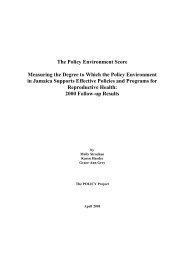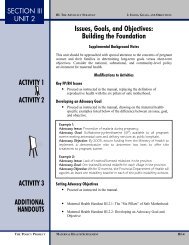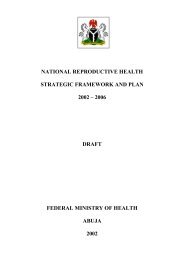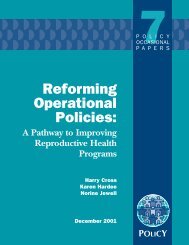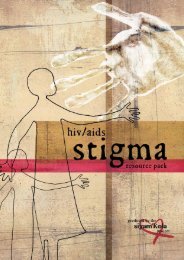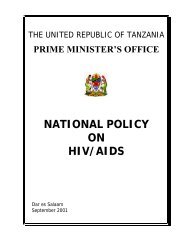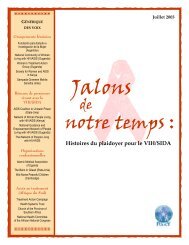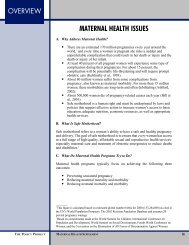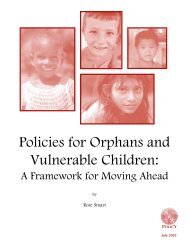THE OVC RAAAP FINAL REPORT - POLICY Project
THE OVC RAAAP FINAL REPORT - POLICY Project
THE OVC RAAAP FINAL REPORT - POLICY Project
Create successful ePaper yourself
Turn your PDF publications into a flip-book with our unique Google optimized e-Paper software.
Lesson Learned: Investing in community-centered infrastructure while expanding government<br />
services at the community level improves care and support to children.<br />
Families and communities—particularly women—have expertise in identifying and responding to the<br />
needs of <strong>OVC</strong>. It seems evident, therefore, that national <strong>OVC</strong> strategic planning and resource allocation<br />
must be centered at the community level.<br />
Capitalizing on communities’ and caregivers’ <strong>OVC</strong> knowledge is a smart financial strategy that will<br />
guarantee stronger returns on dollars invested. This includes bolstering existing community <strong>OVC</strong><br />
programs, community-based children’s care centers, and other mechanisms by building staff and program<br />
capacity around the already-existing nuclei of response found in community after community. Equally as<br />
important, it means integrating poverty reduction strategies focused on community economic vitality with<br />
an <strong>OVC</strong> policy and national HIV/AIDS goals that also recognize communities as principal beneficiaries<br />
and implementing forces.<br />
A functioning and vital <strong>OVC</strong> sector represents an incredible opportunity for democratic and economic<br />
stabilization throughout the region. It should be strengthened by focusing donor funds and expanding<br />
government services for <strong>OVC</strong>, while reducing poverty at the community level by generating <strong>OVC</strong> sector<br />
jobs. For instance, local community <strong>OVC</strong> care coordinators could be hired to track individual <strong>OVC</strong> cases<br />
and households with children in need, to improve data collection, and to monitor the quality of <strong>OVC</strong><br />
support services and delivery mechanisms. Hiring from within the community and coordinating<br />
government services with community-led initiatives would help boost the local economy while<br />
reinforcing a deep sense of community ownership for <strong>OVC</strong> support and programming.<br />
Framework Strategy #3: Ensure access for <strong>OVC</strong> to essential services, including education,<br />
healthcare, and birth registration.<br />
Unfortunately, despite great efforts on the part of governments, donors, INGOs, and local NGOs, the<br />
<strong>OVC</strong> Desk Reviews found that only a small percentage of vulnerable children were receiving even one<br />
basic service. It is possible that these low figures are as much a reflection of poor monitoring and<br />
evaluation systems found across all 17 countries as they are true assessments of the number of <strong>OVC</strong><br />
receiving services. Regardless, these are the most comprehensive coverage numbers to date, and they<br />
indicate extremely low numbers of <strong>OVC</strong> currently receiving services, support, and other assistance.<br />
Key Findings:<br />
• Out of an estimated 10.6 million children orphaned and made vulnerable by AIDS in sub-Saharan<br />
Africa, it is estimated that 914,000 are receiving even one essential service, such as food, healthcare,<br />
education, psychosocial support, or protection. This means that only 8.6 percent of the total<br />
estimated number of orphans and vulnerable children due to AIDS are receiving at least one essential<br />
service.<br />
• In a number of <strong>OVC</strong> <strong>RAAAP</strong> countries, <strong>OVC</strong> Desk Reviews found that donors, governments, and<br />
NGOs were unable to track how many <strong>OVC</strong> were receiving services and support or how much<br />
money was earmarked for them. This was due in part to decisions made to protect orphans from<br />
stigma and discrimination by merging assistance funds for <strong>OVC</strong> into such general aid categories as<br />
HIV/AIDS, Children, and Youth. However, findings of such poor coverage call into question how<br />
effectively children and youth are being prioritized within national HIV/AIDS plans and how well<br />
human rights covenants are genuinely being upheld.<br />
7



